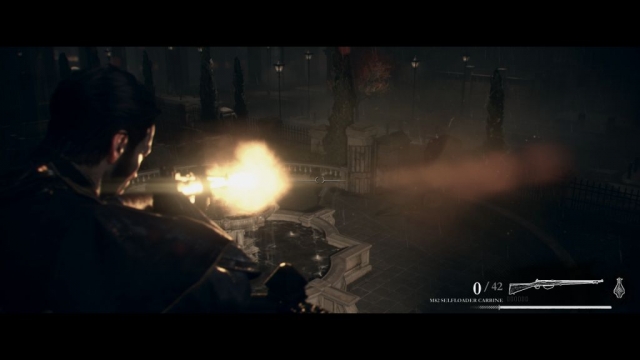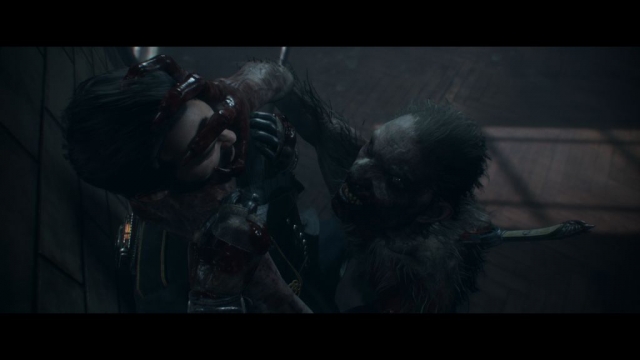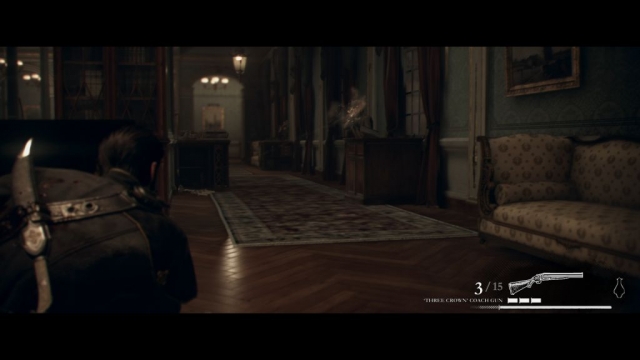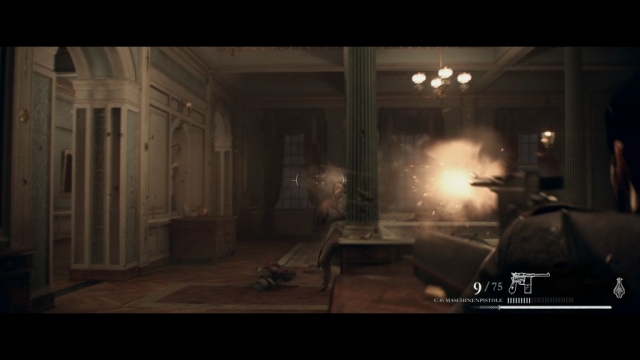The Order: 1886
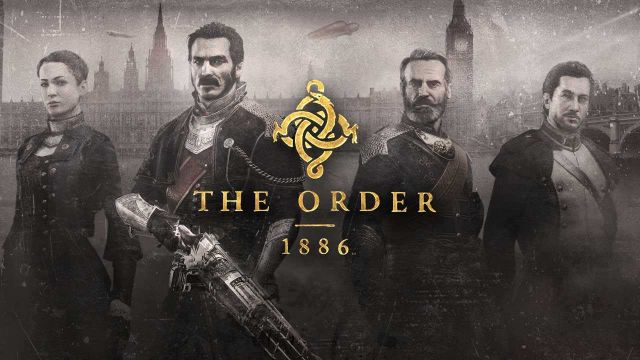
Grayson, also known by his knight title Sir Galahad, is a member of the Knights of the Round Table, more commonly known as the Order. Formed centuries ago by King Arthur, the Order exists to protect the British Isles from half-breeds, a species of bestial humans, as well as other potential threats. The year is 1886, and technological advancements of the Industrial Revolution have begun to turn the tide in favor of the Order in its war with the half-breeds. When a new faction of human guerilla fighters known as the Rebels are rumored to have allied with the Lycans, Sir Galahad and his crew are sent to investigate, but Grayson slowly discovers an even darker secret – one that threatens to change the course of history forever. This is The Order: 1886.
That’s about all I’m comfortable revealing about the plot of The Order: 1886. With its many twists and turns, it’s a story that – to fully enjoy – you’ll want to avoid any and all spoilers. What I can tell you, if the Lycans weren’t clue enough, is that The Order takes place in an alternate history where myths and technology co-exist; where inventor and engineer Nikola Tesla is to the Order as Q is to James Bond and the British Secret Service; and where Jack the Ripper terrorizes the impoverished district of Whitechapel two years sooner. It’s a unique vision of Victorian-Era London – one that works exceedingly well within the framework of the game.
What I can also tell you is The Order: 1886 is a highly cinematic, narrative-driven experience similar to The Last of Us and Uncharted. Yes, some of the chapters lean heavily on interactive cutscenes and quick-time events. Yes, the game is very methodical in the beginning – introducing its cast of characters, developing their relationships, and setting up the plot. Yes, when the game concludes the story doesn’t quite, leaving several loose threads. For me, these aren’t necessarily negatives. If anything, I would have been disappointed if developer Ready at Dawn had rushed to tie everything up into a neat little bow. These are conflicts and relationships with the potential for huge payoffs down the road. Why rush to resolve them? The developer’s intention is clear. The Order was made to be a franchise, so you need to approach this game like you would the upcoming Star Wars film – knowing this is just the beginning of an overarching story.
The Order: 1886 shares more in common with The Last of Us and Uncharted than just its approach to storytelling and emphasis on character development. Equally comparable is gameplay, consisting of third-person shooting, melee combat, exploration, and puzzle-solving. Cover-based shootouts are the chief component, offering familiar controls for peeking over or around cover, vaulting over cover, and using blind-fire. “Soft-cover” is a nice added touch. When you slowly back away from cover, Galahad will stay low and automatically slip into any cover that you move him into, instead of exposing himself to gunfire. In more intense firefights you can activate Blacksight, a slow-motion mechanic that allows you to quickly target enemies in lieu of aiming manually. The Order’s arsenal isn’t bountiful, but it sure does pack a punch. Highlights include the Arc Gun, an experimental weapon that fires streams of electricity; the Thermite Rifle, a light machine gun that can fire a highly flammable magnesium shot; and the ‘Three Crown’ Coach Gun, a triple-barreled shotgun that is especially brutal in close quarters. Most of the weapons have two modes of fire, and every weapon feels really good in combat.
Surprisingly, most of the enemies you’ll fight in the game are human. Encounters with half-breeds, at least in beast form, are few and far between. I suppose the intent was to make these confrontations more memorable, but they’re kind of a letdown despite their intensity. Brushes with Lycans fall into two categories: standard and boss battles. A standard fight consists of dodging the half-breeds attacks until you’ve filled them with enough lead to perform a melee finisher, while boss battles are almost entirely quick-time events.
I’m not sure how I feel about melee combat; a term I use very loosely in this game. To perform a melee attack you must first get near an enemy, wait for the button prompt to appear, and then properly time said button press. In other words, you can’t just melee anyone whenever you feel like it. It’s a mechanic that you can actually fail at, and if you happen to fail the quick-time portion of a melee strike while stealthily sneaking up on an enemy, the result is instant death. Your target will turn around and shoot you in the face (or something to that effect). So yeah, not sure I’m totally on board with that design decision.
The other issue I have with combat is that it’s far too linear. Most of the firefights take place in corridors and alleyways, and even when the environment opens up, the opportunity to flank an enemy or choose an alternate path rarely presents itself. As a result, the game lacks replayability outside of retrieving collectibles. Overall, I’d describe The Order’s gameplay as serviceable but uninspiring.
Where The Order: 1886 excels, arguably beyond any game released to date, is production values. The graphics and art design are outstandingly good. The cinematics are rendered entirely in-engine, so the transition to gameplay is seamless. From the gritty slums of Whitechapel to the holy Palace of Westminster, Victorian-Era London has been meticulously crafted down to the finest detail. Throughout the game, Galahad will come across items of interest. Players can pick up these items and examine them using the left stick. It’s here where the game’s incredible level of detail truly shines. An object as simple as an apple or pamphlet, to more complex items like a weapon or gadget, all look photo-realistic. Whether it’s character models, animations, environments, lighting or textures, the visuals are quite simply superb.
Sound design is equally brilliant, starting with the soundtrack. A bassy score featuring a string orchestra and an all-male choir, the soundtrack is perfect in tone and worth owning and listening to on its own. The voice cast is full of fresh faces, each delivering a stellar performance, and the sound effects are first-rate – particularly the weapon effects which add a great deal of weight to firefights.
There’s an elephant in the room, so let’s address it. How long does it take to complete The Order: 1886? The campaign clocks in at around 8 hours, depending on the difficulty setting, how thorough an explorer you are, and whether or not you stop to take in the sights and sounds of London. “Hang on,” you say, “I watched someone on YouTube finish the game in just over 5 hours.” Then you may want to reconsider the way you play videogames.
As The Order: 1886 takes its place next to The Last of Us and Uncharted, it would appear Sony has cornered the market on highly cinematic, narrative-driven experiences that blend third-person shooting, exploration and puzzle-solving. The game is not without faults – it’s very linear, leans a little too much on quick-time events, and gameplay is merely average – but the experience is elevated by excellent storytelling, compelling characters, stunning graphics and art design, and sublime sound design. In the end, The Order: 1886 is a very good game that sets the stage for a potential blockbuster franchise. Now it’s up to Ready at Dawn to follow through.
Reviewed By: Stephen Riach
Publisher: Sony Computer Entertainment
Rating: 85%
——————————————————————————–
This review is based on a retail copy of The Order: 1886 for the PlayStation 4 provided by Sony Computer Entertainment.
 Game Over Online
Game Over Online